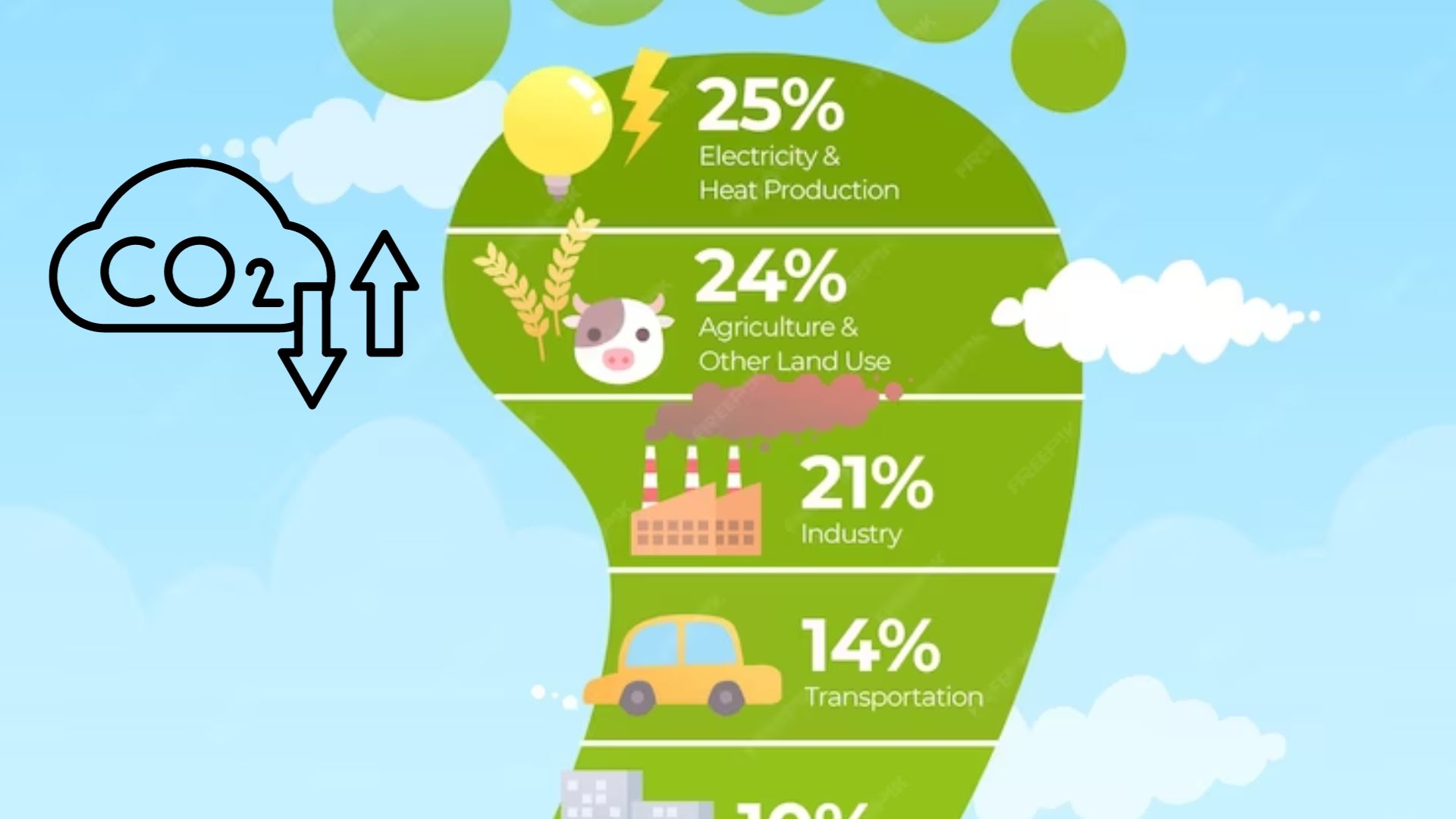
Danielle Tan
Chief Operating Officer
The ISO 14064-1 standard provides guidelines for organizations to quantify, monitor, and report greenhouse gas emissions and removals. This aims to explain the purpose and scope of ISO 14064-1, helping readers understand its importance in greenhouse gas reporting and environmental management.

In 2022, the amount of carbon dioxide (CO2) emissions from energy consumption in Malaysia amounted to approximately 272.9 million metric tons, an increase compared to the previous year. The amount of CO2 emissions from fossil fuel energy consumption in Malaysia was at its highest in that same year (Statista Research Department, Sep 26, 2023).
Malaysia is committed to achieving net zero greenhouse gas (GHG) emissions by 2050. To fulfill this pledge, the government is actively crafting the Long-Term Low Emissions Development Strategy (LT-LEDS). The primary objective of the LT-LEDS is to outline practical programs and policies that are essential today for achieving measurable reductions in GHG emissions, aligning with the goals of the United Nations Framework Convention on Climate Change (UNFCCC). This strategy will not only facilitate Malaysia’s orderly and equitable transition to a low-carbon, climate-resilient economy by 2050 but will also pinpoint opportunities across various sectors.
The LT-LEDS plays a pivotal role in enabling businesses and financial institutions to align their strategies with GHG emission reduction. As the LT-LEDS nears completion, the government is also taking steps to establish crucial foundations and infrastructure that will support the shift toward a low-carbon economy. These measures encompass the introduction of a legislative framework and the implementation of a carbon pricing system.
A notable milestone in this endeavor is the launch of the Bursa Carbon Exchange (BCX) on December 9, 2022. The BCX is a voluntary carbon market that enables businesses to meet climate targets by trading carbon credits derived from activities or projects that mitigate or prevent GHG emissions. This article focuses on the fundamental principles and approaches of carbon accounting, which underpin carbon pricing and trading systems, and how it plays a vital role in measuring progress toward Malaysia’s net zero emissions aspirations.
The Intersection of EHS and ESG
EHS and ESG are interconnected in several ways. EHS practices address a company’s environmental impact, occupational health and safety, and regulatory compliance. An effective EHS program safeguards employees, minimizes environmental harm, and ensures that the organization operates within the boundaries set by local and international laws and regulations. These EHS practices inherently contribute to the “E” (Environmental) aspect of ESG.
Additionally, a strong EHS program can positively influence the “S” (Social) component of ESG. It promotes employee well-being, workplace safety, and a culture of responsibility. A healthy and safe work environment enhances the company’s reputation and fosters a positive relationship with its workforce. EHS practices not only reduce the risk of accidents and injuries but also demonstrate a commitment to employees’ welfare, which aligns with the broader social responsibility that is central to ESG.
Lastly, EHS practices can impact the “G” (Governance) aspect of ESG by emphasizing transparency, accountability, and ethical decision-making. Effective governance is integral to risk management, and an EHS program reinforces governance by establishing clear standards, processes, and reporting structures. This clarity is essential for tracking and managing ESG-related data, ensuring compliance, and mitigating risks associated with environmental and social issues.
In essence, EHS practices provide a strong foundation for building an ESG strategy that is meaningful and credible.

Commonly Used Carbon Accounting Frameworks
(Source: Corporate Finance Institute)
- Greenhouse Gas Protocol- The Greenhouse Gas Protocol is a widely recognized and widely used framework for accounting and reporting greenhouse gas emissions. It was developed by the World Resources Institute (WRI) and the World Business Council for Sustainable Development (WBCSD). This framework is considered a global standard for organizations, businesses, and governments to measure, manage, and report their greenhouse gas emissions. It provides comprehensive guidance on defining emission sources, categorizing emissions into scopes (Scope 1, Scope 2, and Scope 3), and methods for quantification. The Greenhouse Gas Protocol has played a pivotal role in standardizing and harmonizing emissions reporting worldwide, helping organizations track and reduce their carbon footprint effectively.
- The EPA GHG Inventory Guidance– The U.S. Environmental Protection Agency (EPA) Greenhouse Gas Inventory Guidance is a specific framework designed for organizations and entities within the United States. It offers detailed instructions and methodologies for calculating and reporting greenhouse gas emissions, with a focus on ensuring compliance with U.S. regulatory requirements. This guidance helps entities understand how to report emissions data to the EPA, and it serves as a valuable resource for businesses and industries subject to U.S. regulations, such as the Clean Air Act.
- The Climate Registry General Reporting Protocol (GRP)– The Climate Registry’s General Reporting Protocol (GRP) is a comprehensive framework that provides guidance on how organizations can calculate, report, and verify their greenhouse gas emissions. The Climate Registry is a non-profit organization that primarily operates in North America. The GRP offers a flexible and robust structure for entities to report their emissions, encompassing direct and indirect emissions, and aligning with international standards. It is particularly useful for entities operating within the regions where The Climate Registry operates.
- ISO Standard 14064– ISO 14064 is a set of international standards developed by the International Organization for Standardization (ISO) that specifically addresses greenhouse gas accounting and verification. ISO 14064 consists of three parts: Part 1 focuses on the principles and requirements for designing, developing, managing, and reporting on greenhouse gas inventories; Part 2 provides guidance for greenhouse gas projects and validation and verification of emissions reductions or removals; and Part 3 offers guidance for the validation and verification of greenhouse gas assertions. ISO 14064 is recognized globally and provides a structured approach to ensure consistency and accuracy in emissions accounting and reporting for organizations and projects.
The Greenhouse Gas Protocol recommends the hybrid methodology, which is the most used carbon measurement methodology given its pragmatic approach. While it is usually more accurate to use information about activities of a business to measure how much carbon it is producing as compared to the spend-based data, such information is not as readily available and can be time consuming to gather.

Approaches to Measure Carbon Emissions
(Source: Greenhouse Gas Protocol)
- Spend-based Approach
Financial value of a purchased good/ services multiplied by an emission factor ($/CO2 e).
Example: Business travel emissions based on price of a plane ticket multiplied by industry average emissions level.
- Activity-based Approach
Raw data from organizational activities across the supply chain quantified into emissions data (Activity Metric/CO2 e).
Example: Business travel emissions based on the plane model, fuel used, class of ticket and actual flight route.
- Hybrid Methodology
Activity-based data across the supply chain and spend-based approach for other areas (CO2 e).
Example: Business travel emissions based on combination of (i) historical data about the flights taken if available and (ii) cost of ticket (price) based on company expenses data multiplied by national average emissions level otherwise.

Significance of Carbon Accounting for Businesses
The importance of carbon accounting for businesses is on the rise. Shareholders and investors are increasingly demanding climate-related disclosures from the companies they invest in. These disclosures encompass information about greenhouse gas (GHG) emissions, which is crucial for aiding their investment choices and ensuring compliance with regulatory obligations. Financial institutions that have committed to achieving net zero targets are also beginning to mandate GHG emissions disclosures as they evaluate and reveal the emissions associated with their loans and investments.
Furthermore, prominent players in the investment realm, such as large asset owners and asset managers at the forefront of the investment chain, are making substantial efforts to provide more comprehensive financial disclosures related to climate considerations. This enhanced transparency is designed to bolster climate objectives and is having a significant impact on financing and investment decisions.
Consequently, the ability of businesses to accurately measure and report their emissions is becoming increasingly essential. This capability is instrumental in accessing the necessary capital, potentially at a lower cost. Simultaneously, governments and regulators worldwide are intensifying their efforts to expedite progress toward climate objectives and enhance disclosures concerning carbon emissions.
Current and Emerging Regulatory Requirements on Climate and Sustainability Disclosures
- International Sustainability Standards Board requirements
Global baseline of sustainability disclosures to meet information needs of investors in assessing enterprise value. Companies are expected to disclose absolute gross GHG emissions level.
Impact to Businesses
Access to capital- Investors and financial institutions will require businesses to enhance disclosures e.g. Metrics and targets.
Enterprise valuation- Businesses long-term viability is assessed based on their adaptability in integrating climate-related risks and opportunities.
- Carbon Border Adjustment Mechanisms
Carbon tariffs/fees applied on imported goods based on GHG emissions generated during their production.
Impact to Businesses
Price competitiveness for exports – Higher price as fees/carbon tariffs will be imposed on goods exported to imposing jurisdiction • Potential gain/loss in market share – Suppliers along the supply chain may gain or lose market share should their client decide to switch to “greener” suppliers.
- Bursa Malaysia Sustainability Reporting Framework
Enhanced sustainability reporting requirements for Main and ACE markets.
Impact to Businesses
Access to capital- businesses with clear sustainability commitments have better access to financing or investments.
Penalty for non-compliance- listed companies that do not adopt may face enforcement actions by Bursa Malaysia which includes potential delisting.
Conclusion
Manufacturers in Malaysia can address greenhouse gas reporting through proactive steps.
- Start by implementing robust data collection and monitoring systems to accurately measure emissions.
- Adopt recognized frameworks such as the Greenhouse Gas Protocol or ISO standards to standardize reporting.
- Collaborate with industry peers and government initiatives to share best practices and access support.
- Consider investments in eco-friendly technologies and processes to reduce emissions.






